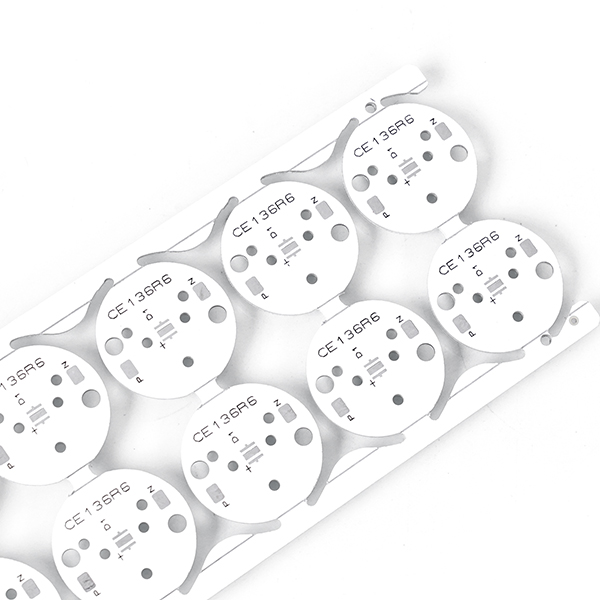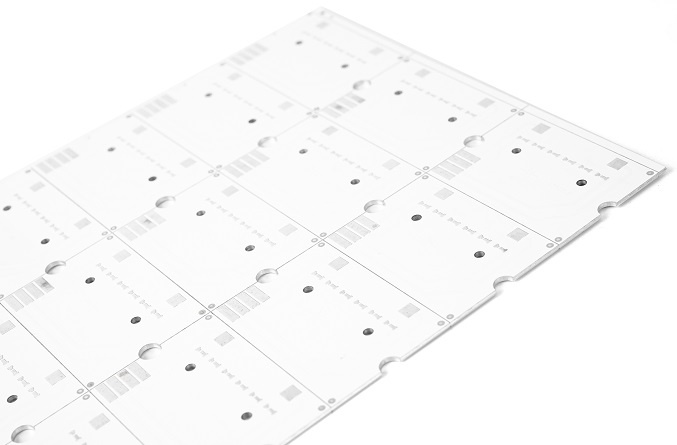Aluminum PCB VS FR-4 Performance Comparison
- Views
- 12 Apr 2024
- What is the coefficient of thermal expansion?
- Which company is stronger in application field?
- What are the electrical properties of aluminum PCB?
- Insulating properties
- What are the classifications of aluminum PCB?
- Main uses of aluminum substrate
The biggest difference between aluminum-based copper-clad laminates and conventional FR-4 copper-clad laminates is heat dissipation. Comparing the 1.5mm thick FR-4 copper clad laminate with the aluminum-based copper clad laminate, the former has a thermal resistance of 20~22°C and the latter has a thermal resistance of 1.0~2.0°C. Aluminum substrates are better at quickly dissipating the heat generated during circuit operation, thereby effectively reducing system temperature and improving work efficiency and reliability.
What is the coefficient of thermal expansion?
Since general FR-4 has thermal expansion problems, that is, high temperatures will cause changes in the thickness and flatness of the board, especially thermal expansion in the thickness direction of the board, which will affect the quality of metallized holes and lines. The main reason for this is that the thermal expansion coefficient of the raw material of the board is different in the thickness direction: the thermal expansion coefficient of copper is 17×106cm/cm℃, and the FR-4 board base material is 110×106cm/cm℃. There is a big difference between the two and it is easy to cause thermal expansion. effect. The thermal expansion coefficient of the aluminum substrate is 50×106cm/cm℃, which is smaller than the general FR-4 board and closer to the thermal expansion coefficient of copper foil. This will help ensure the quality and reliability of printed circuit boards.

Which company is stronger in application field?
In applications, FR-4 boards are suitable for general circuit design and general electronic products. Compared with FR-4, aluminum substrate is suitable for circuits with special heat dissipation requirements. For example: heat dissipation of thick film hybrid integrated circuits, power circuits, heat dissipation and cooling of components in the circuit, and circuits whose reliability cannot be solved by using ordinary radiators.
What are the electrical properties of aluminum PCB?
From the comparison between aluminum substrate and FR-4 board, due to the high heat dissipation of aluminum PCB, the wire fusing current is significantly improved, which shows the high heat dissipation characteristics of aluminum substrate from another perspective. The heat dissipation performance of the aluminum substrate is related to its insulation layer thickness and thermal conductivity. The thinner the insulation layer, the higher the thermal conductivity of the aluminum substrate (but the lower the voltage resistance).
Insulating properties
Under normal conditions, the withstand voltage value of the aluminum substrate is determined by the thickness of the insulating layer. The withstand voltage value of the aluminum substrate is generally around 500V. If you need to test the withstand voltage value of the aluminum substrate of the LED fluorescent lamp, just Just perform a high-voltage test on the input port housing.

What are the classifications of aluminum PCB?
Aluminum-based copper clad laminates are divided into three categories:
1.General-purpose aluminum-based copper-clad laminate, the insulation layer is composed of epoxy glass cloth adhesive sheet;
2.High heat dissipation aluminum-based copper-clad laminate, the insulation layer is composed of high thermal conductivity epoxy resin or other resin;
3.Aluminum-based copper-clad laminate for high-frequency circuits, the insulation layer is composed of polyolefin resin or polyimide resin glass cloth adhesive sheet.

Main uses of aluminum substrate
1.Lighting products, high-power LED lighting products.
2.Audio equipment, preamplifiers, power amplifiers, etc.
3.Power supply equipment, DC/AC converters, rectifier bridges, solid-state relays, etc.
4.Communication products, high-frequency amplifiers, filter electrical appliances, and transmitting circuits.
Aluminum PCB and FR-4 have their own characteristics. Aluminum PCB plays an important role in the design of certain electronic products with high power and high heat dissipation requirements due to its excellent heat dissipation performance, thermal expansion coefficient and other properties. If you want to know more, please pay attention to our website, we will launch more product introductions from time to time.
Aluminum PCB, Aluminum PCB Application, electrical properties of aluminum PCB,
Related Blog
- What is Thermal and Electrical Separating Pad in Metal Core PCB?
- LED PCB Assembly Process: Step-by-Step Guide for Beginners
- Why Always Recommend White Solder Mask Black Silkscreen for Aluminum PCB?
- What Materials Are Commonly Used for Manufacturing Lighting PCBs?
- Everything You Should Know About Metal Core Circuit Board
- What Are the Differences Between Ceramic PCB, Metal Core PCB And Standard FR4 PCB?
- Why Choose Best Technology As Your MCPCB Manufacturer?
- What is LED Light Circuit Board and How to Make it?
- When is International Labour Day in 2024 and What are the Significances of It?
- How Does A Convexity Comes Out On Thermoelectric Separation Copper Based PCB?
- Why is Aluminum LED PCB Important for Indoor Growth Lights?
- Application of Metal Core Pcbs in the Development of LED Technology
- Why Choose White Solder Mask for Metal core PCB When Used In LED Devices?
- Understanding Aluminum LED PCBs in 1000w LED Grow Lights
- What Are the Advantages of Metal Core PCB? How to Choose?
- Automotive Light Copper Core Pcb Production Process—testing
- Why Are Metal Core PCBs, Especially Copper Core, Used In Heat-Sensitive Electronics?
- How do aluminum LED PCBs improve LED efficiency?
- What Are the Differences Between Regular and Thermoelectric Separation Copper-Base PCBs?
- Aluminum PCB VS FR-4 Performance Comparison



